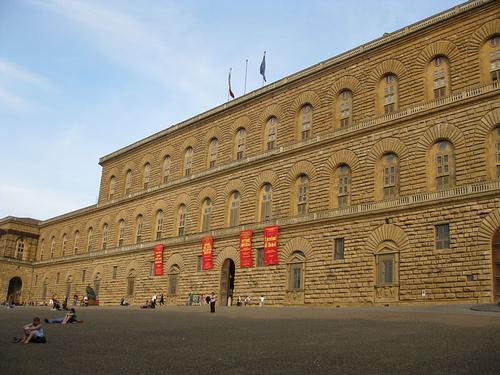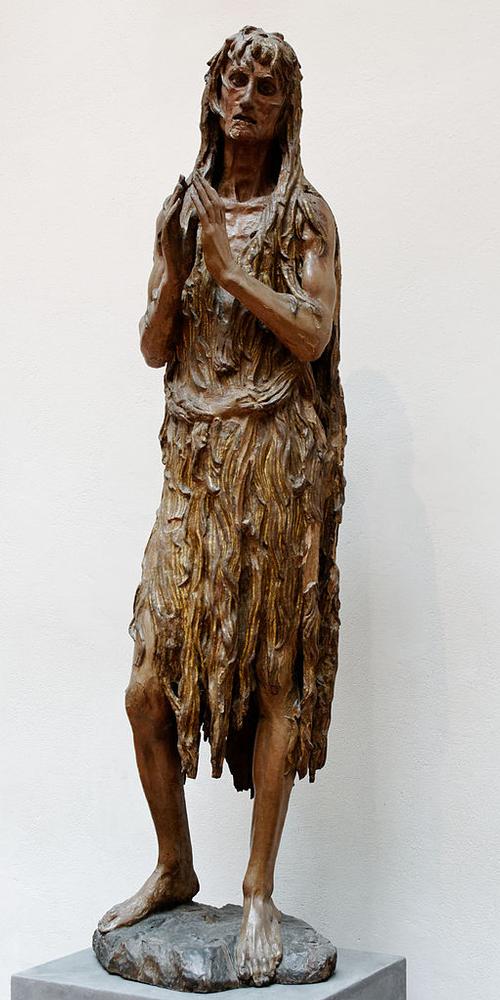ITALY
Florence

Florence
Florence
 Florence View from the Duomo Photo: Ian Furst CC 3.0 Unported no changes made
Florence View from the Duomo Photo: Ian Furst CC 3.0 Unported no changes made
Florence is the capital of the Tuscany region and is one of the most important historical cities in the country. The city is full of beautiful Renaissance-style buildings, including beautiful churches and huge palaces. Florence is steeped in culture and atmosphere and the inner city has not changed much since the 16th century.
| advertisement |
| Hotels Florence |
Location
 The Arno flows through FlorencePhoto: Yair Haklei CC Unported no changes made
The Arno flows through FlorencePhoto: Yair Haklei CC Unported no changes made
Florence is located on the River Arno that cuts the city in half in a valley with many olive groves between the Tuscan hills. The Apennines are located northeast of the city. The center is quite compact and most of the sights are within walking distance of each other. Many parts of Florence are car-free and if you are in the center, the fastest way to get around the city is on foot.
Weather
The climate of Florence is typically Mediterranean, with high temperatures and sunny days in the summer and colder and wetter weather in the winter. July and August are usually very hot with temperatures of around 30 °. In the spring and autumn, the temperature feels pleasant and comfortable. The weather is often unpredictable from November to February, when there are relatively few tourists in the city. Although it is generally quite mild with lots of sun, heavy rain can suddenly fall with an icy wind. So make sure to bring a warm overcoat, scarf and gloves.
History
The area around Florence was already inhabited in prehistoric times. The current city was founded in the year 59 BC as a settlement for soldiers of Julius Caesar. Florence was given a forum, several temples and communal baths. The Arno River was outside the city walls at that time. Christianity made its appearance in the 2nd century AD. One of the earliest churches is San Lorenzo, consecrated in AD 393.
 Cosimo de MediciPhoto: Public Domain
Cosimo de MediciPhoto: Public Domain
The great prosperity of Florence begins from 1115, when the Florentine Republic is founded, which was ruled in the 14th and 15th centuries by the Medici banking family who had a great interest in architecture and art. It was during this time that the most important structures such as the Duomo, the Bargello, the Palazzo Pitti and the Palazzo Vecchio came about and artists and scientists such as Leonard DaVini, Botticelli and Michelangelo achieved world fame. After the Renaissance, Florence was ruled by a succession of leaders, none of whom were particularly effective. After the unification of Italy in the 19th century, the city briefly became the capital of the new state, until Rome finally took over that position in 1870. During the Second World War, Florence was occupied by German troops. Allied aerial bombardments destroyed many beautiful buildings. In August 1944, retreating German troops blew up all bridges in the city with the exception of the Ponte Vecchio.
In 1966, parts of Florence were flooded when the Arno River burst its banks. Numerous art treasures and antique books were damaged. The disaster sparked a worldwide rescue effort, with volunteers from all over the world coming to Florence to lend a hand.
Sights
There is an incredible amount to see in Florence, below are some of the most famous sights, especially from the Renaissance.
 Uffizi MuseumPhoto: Chris Wee CC 2.0 Generic no changes made
Uffizi MuseumPhoto: Chris Wee CC 2.0 Generic no changes made
The famous and enormous Uffizi Gallery is located on the banks of the Arno River and the beautiful art collection is decorated to illustrate the art story of Florence. There are many famous masterpieces on display, such as Botticelli's Birth of Venus, Titian's Venus of Urbino, Michelangelo's Holy Family and Piero della Francesca's “Duke and Duchess of Urbino”. The museum owns the art collection of the de Medici family, who were bequeathed to Florence in 1737, on condition that it never left the city. Partly because of this, the Uffizi Gallery remains one of the most important art museums in the world.
 Michelangelo's David Florence Photo: Marcus Obal CC 3.0 Unported no changes made
Michelangelo's David Florence Photo: Marcus Obal CC 3.0 Unported no changes made
The Galleria dell'Accademia is without a doubt most famous for its sculptures of the great Michelangelo. His Prisoners (or Slavs), his Matthew and above all the beautiful statue of David ensure that hundreds of thousands of tourists visit the museum every year. The main halls of the Accademia also offer visitors works by other great Italian artists such as Sandro Botticelli, Domenico Ghirlandaio, Pontormo, Andrea del Sarto, Allessando Allori and Orcagna, just to name a few of the most famous painters.
 Palazzo Pitti in FlorencePhoto: Deror Avi CC 3.0 Unported no changes made
Palazzo Pitti in FlorencePhoto: Deror Avi CC 3.0 Unported no changes made
Located on the south bank of the Arno River, the Pitti Palace was designed by Brunelleschi for the Pitti family. This huge palace is quite imposing and features some beautiful works of art from the likes of Raphael, Filippo Lippi, Tintoretto, Veronese and Rubens - all on display in beautifully decorated rooms. The palace is also home to a collection of modern art and a costume collection.
 Bargello in FlorencePhoto: Terrasque CC 3.0 Unported no changes made
Bargello in FlorencePhoto: Terrasque CC 3.0 Unported no changes made
The Bargello is a huge building built in 1255 and it was originally the police headquarters and also a prison. The Bargello is now home to the National Museum, which contains one of the most impressive collections of Renaissance sculpture in the world. Highlights include works of art such as Michelangelo's 'Drunken Bacchus', Donatello's 'David', Giambologna's 'Mercury' and also the designs submitted by Brunelleschi for the doors of the Duomo.
 Duomo FlorencePhoto: Morio CC 3.0 Unported no changes made
Duomo FlorencePhoto: Morio CC 3.0 Unported no changes made
The Duomo, or Florence Cathedral, is in the heart of the city. Dominating the city with its enormous dome, the Church was designed in 1334 by city architect Giotto and completed in 1359, although it took almost two centuries to finally complete. Today it is still the tallest building in Florence and one of the city's most famous landmarks. The huge dome was designed by Brunelleschi and it was a revolutionary achievement as it was the largest dome of the time and was built without scaffolding. The inner shell provided a platform for the beams that supported the outer structure. There are 463 steps that lead to the top of the dome, where visitors can enjoy panoramic views of the city. Other highlights include the many beautiful frescoes, detailed ceiling mosaics and stained glass windows created by some of the great artists of the time, such as Vasari, Zuccari, Donatello, Uccello and Ghiberti.
 San Lorenzo Basilica in FlorencePhoto: Sailko CC 3.0 Unported no changes made
San Lorenzo Basilica in FlorencePhoto: Sailko CC 3.0 Unported no changes made
The San Lorenzo Basilica was designed and built by Brunelleschi between 1419 and 1469 and is widely regarded as one of the purest Renaissance churches. It was the very first church of this style to be built in the city. The eastern facade has no decoration and the antique brickwork is clearly visible. There is plenty to admire inside, including bronze pulpits designed by Donatello, buried in one of the chapels. There is also a simple stunning staircase built by Michelangelo in the Laurenziana Library and the richly decorated Medici chapels.
 Santa Croce Basilica in FlorencePhoto: Clement Bardot CC 4.0 International no changes made
Santa Croce Basilica in FlorencePhoto: Clement Bardot CC 4.0 International no changes made
The Santa Croce Basilica is a beautiful, large Franciscan church that is more than 500 years old. The facade of the building consists of colorful marble laid in a geometric pattern and the church has beautiful frescoes by Giotto, two sculptures by Donatello and an octagonal marble pulpit by Benedetto da Maiano. Michelangelo, Macchiavelli, Galileo and Bardi, among others, are buried here.
Tips
 Donatelle statue of Maria Magdalena in FlorencePhoto: Marie-Lan Nguyen CC 2.5 Generic no changes made
Donatelle statue of Maria Magdalena in FlorencePhoto: Marie-Lan Nguyen CC 2.5 Generic no changes made
The Duomo's awe-inspiring museum houses beautiful works of art. Among the many sacred and liturgical treasures is Ghiberti's original 15th century masterpiece, “Doors of Paradise”, the 16 meter high gilt bronze doors designed for the east entrance to the Baptistery. You can also see Michelangelo's painfully beautiful La Pietà, sculpted when he was nearly 80 and intended for his own tomb. In Room 8, the Sala della Maddalena, it is impossible not to be moved by Donatello's famous wooden statue of a skinny, desperately abandoned Mary Magdalene. A work from the mid-15th century, completed late in the sculptor's career. Rooms 14 and 15 explain in detail how Brunelleschi built the pioneering cathedral dome. Look at tools from the 15th century, pulleys, hoists, and hoists used to build the dome.
 Boboli Gardens in FlorencePhoto Stefan Bauer CC 2.5 Generic no changes made
Boboli Gardens in FlorencePhoto Stefan Bauer CC 2.5 Generic no changes made
The Boboli Gardens were created for the Medici after they bought the Pitti Palace in 1549. First opened to the public in 1766, they are a wonderful example of Renaissance gardens. The gardens are formal in design and consist of hedges neatly trimmed in geometric patterns. Highlights include the Kaffeehaus (coffee house), a Rococo-style pavilion built in 1766, La Grotta Grande built in 1583, the L'Islotto (small island) in the center of the moated castle, and also the Orangery, which was built in 1785. Because the Boboli Gardens are high, you get the best views of Florence from here.
 Marini Marino Museum in FlorencePhoto:Saiklo CC 3.0 Unported no changes made
Marini Marino Museum in FlorencePhoto:Saiklo CC 3.0 Unported no changes made
In addition to all the Renaissance violence, there is a unique museum dedicated to Marino Marini, the famous modern sculptor. What makes this building really special is its fascinating mix of old and contemporary. The museum is housed in the church of San Pancrazio (9th-11th centuries AD) and the architecture integrates ancient elements with modern ones (with beams dating back to the period when the church was used as a tobacco factory, for example). The works on display consist of sculptures donated to Florence by Marino Marini, enriched by the many works of art later donated by his widow. The collection does not follow a chronological order, but a thematic order. The sculptures are rough and essential shapes with horse and rider as recurring subjects. Pomona, the traditional feminine symbol of fertility since the time of the Etruscans, is another recurring symbol.
Useful links Florence
BBC Country ProfilesWorld Fact Book Explore all Countries
How to call
Last updated June 2025
Copyright: Team - The World of Info